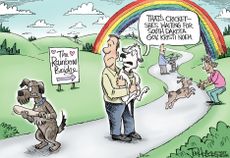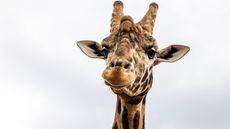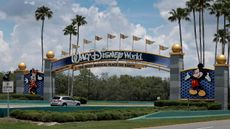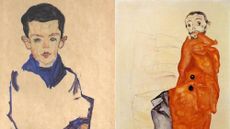How the gay pride movement started
This year marks 50 years since the first UK protest for equality

The UK’s biggest Pride event, Pride in London, will take place tomorrow to celebrate the LGBT+ community and fight for equality.
The 2022 Pride Parade will involve more than 30,000 participants, starting at Hyde Park Corner and ending at Whitehall Place.
Today marks the 50th anniversary of the first historic protest in the UK, when “hundreds of queer people marched defiantly through the streets of London to demand that they be treated with respect by a society that loathed them”, said Pink News.
Subscribe to The Week
Escape your echo chamber. Get the facts behind the news, plus analysis from multiple perspectives.

Sign up for The Week's Free Newsletters
From our morning news briefing to a weekly Good News Newsletter, get the best of The Week delivered directly to your inbox.
From our morning news briefing to a weekly Good News Newsletter, get the best of The Week delivered directly to your inbox.
But some of the veterans who took to the streets that day have said the official modern celebrations are a far cry from the protest of 1972.
What was the catalyst for the gay pride movement?
On 28 June 1969, riots broke out in the area surrounding New York City’s Stonewall Inn, a bar on Christopher Street in Manhattan. Disputes remain “about how exactly the riots began, but it is agreed that they were the result of police raiding the bar for activity then considered criminal”, said The Independent.
The clashes continued for more than three days, and heralded “a more militant approach – in a more militant era – in which gay people demanded respect and equality, rather than asking for it, or trying to educate the heterosexual population”, Michael Bronski, a professor in women’s and gender studies at Harvard University, told Newsweek.
Yet “there has always been resistance by LGBTQ+ people against oppression – from the law, the police, government officials, church doctrine”, added Bronski, author of A Queer History of the United States. The academic and activist argued that it is a mistake “to elevate ‘Stonewall’ as the sole example”.
“I think that it is useful not to look at how one or two ‘riots’ – Stonewall, Compton Street – had a big effect, but rather how all of the small manifestations of resistance had an overwhelming cumulative effect on the lives of people and the society in which they lived,” he said.
How did Pride begin?
LGBTQ+ communities across the US immediately latched on to the Stonewall riots as an event that cast a spotlight on their cause. In 1970, a committee was formed to commemorate the New York uprising.
It was committee member L. Craig Schoonmaker who suggested “gay pride” as a slogan for their cause. “People did not have power then – even now, we only have some,” Schoonmaker said in a 2015 interview with The Allusionist podcast. “But anyone can have pride in themselves, and that would make them happier as people, and produce the movement likely to produce change.”
That first weekend of commemorations would eventually turn into a month-long series of events and parades, all under the banner of Pride.
The UK’s first Pride march was organised by the Gay Liberation Front (GLF) and held on 1 July 1972. “Our aim was to show that we were proud, not ashamed,” said activist Peter Tatchell in a 2017 HuffPost piece. “Determined to come out of the shadows and stand up for our rights, we wanted to make ourselves visible and demand LGBT liberation.”
Only 700 people turned up to the first march, with most of Tatchell’s friends “too scared” to take part. There was also a “heavy, aggressive police presence”, he added. “They treated us like criminals. It was a bit scary.”
How did the rainbow flag become the symbol?
The movement’s rainbow flag wasn’t introduced until 1978. Before then, the pink triangle had symbolised the LGBTQ+ community.
But “since that image had been used during Nazi Germany to mark ‘sexual deviants’ in concentration camps, plenty of people felt like the triangle wasn’t hopeful enough, or even appropriate”, said lifestyle magazine Bustle.
Artist Gilbert Baker created the first rainbow flag for a San Francisco march organised by a friend, activist Harvey Milk. Baker’s original version had eight stripes rather than the six on the flag today, reported The Washington Post. He explained that he intended each stripe to represent an aspect of the gay identity: “hot pink for sex, red for life, orange for healing, yellow for sunlight, green for nature, turquoise for art, indigo for harmony and violet for spirit”.
What does Pride mean today?
By the 1980s, most major cities in the US held a pride parade, with the tradition soon spreading to various parts of the globe. Whereas groups had often been organised around the Aids crisis, “the 1990s saw greater media visibility for LGBTQ people in public life, leading to more businesses starting to come on board for Pride participation”, said Time. The next decade then saw “greater campaigning for same-sex marriage”.
Katherine McFarland Bruce, author of Pride Parades: How a Parade Changed the World, told the magazine: “I think Pride is a vehicle for LGBT groups to make the issues of the day heard both in their own community and in the wider civic community to which they belong.”
Speaking to the Press Association ahead of Pride in London 2022, Tatchell said many people were “very concerned” that the main official event has become “too corporate and commercial”.
“It often looks like a huge PR, marketing and branding exercise by big companies,” he told the news agency. “The human rights dimension has been lost. The original Pride was both a celebration and a protest. That’s the way it should be this year as well.”
Create an account with the same email registered to your subscription to unlock access.
Sign up for Today's Best Articles in your inbox
A free daily email with the biggest news stories of the day – and the best features from TheWeek.com
-
 5 high-caliber cartoons about Kristi Noem shooting her puppy
5 high-caliber cartoons about Kristi Noem shooting her puppyCartoons Artists take on the rainbow bridge, a farm upstate, and more
By The Week US Published
-
 The Week Unwrapped: Why is the world running low on blood?
The Week Unwrapped: Why is the world running low on blood?Podcast Scientists believe universal donor blood is within reach – plus, the row over an immersive D-Day simulation, and an Ozempic faux pas
By The Week Staff Published
-
 Rishi Sunak's asylum spat with Ireland explained
Rishi Sunak's asylum spat with Ireland explainedIn Depth Irish government plans to override court ruling that the UK is unsafe for asylum seekers
By The Week UK Published
-
 Puffed rice and yoga: inside the collapsed tunnel where Indian workers await rescue
Puffed rice and yoga: inside the collapsed tunnel where Indian workers await rescueSpeed Read Workers trapped in collapsed tunnel are suffering from dysentery and anxiety over their rescue
By Sorcha Bradley, The Week UK Published
-
 Gaza hospital blast: What the video evidence shows about who's to blame
Gaza hospital blast: What the video evidence shows about who's to blameSpeed Read Nobody wants to take responsibility for the deadly explosion in the courtyard of Gaza's al-Ahli Hospital. Roll the tape.
By Peter Weber, The Week US Published
-
 Giraffe poo seized after woman wanted to use it to make a necklace
Giraffe poo seized after woman wanted to use it to make a necklaceTall Tales And other stories from the stranger side of life
By Chas Newkey-Burden, The Week UK Published
-
 Helicopter sound arouses crocodiles
Helicopter sound arouses crocodilesTall Tales And other stories from the stranger side of life
By Chas Newkey-Burden, The Week UK Published
-
 Woman sues Disney over 'injurious wedgie'
Woman sues Disney over 'injurious wedgie'Tall Tales And other stories from the stranger side of life
By Chas Newkey-Burden, The Week UK Published
-
 Emotional support alligator turned away from baseball stadium
Emotional support alligator turned away from baseball stadiumTall Tales And other stories from the stranger side of life
By Chas Newkey-Burden, The Week UK Published
-
 Europe's oldest shoes found in Spanish caves
Europe's oldest shoes found in Spanish cavesTall Tales And other stories from the stranger side of life
By Chas Newkey-Burden, The Week UK Published
-
 Artworks stolen by Nazis returned to heirs of cabaret performer
Artworks stolen by Nazis returned to heirs of cabaret performerIt wasn't all bad Good news stories from the past seven days
By The Week Staff Published